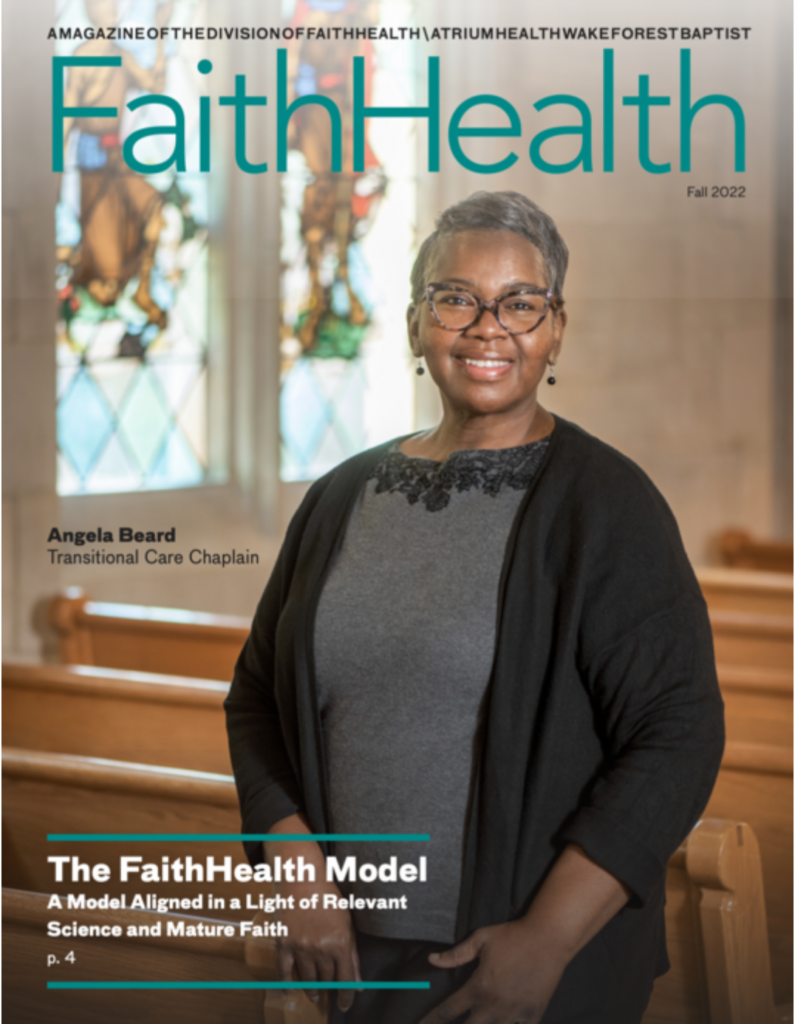From the FaithHealth Division, Wake Forest Baptist Health
Until recently, many pastors simply defaulted to Centers for Disease Control guidelines or NC Department of Health and Human Services guidelines that continued to discourage large gatherings indoors without requiring masking and social distancing. But all of that changed with the May 14 announcement from the CDC indicating that masks should no longer be required in a variety of indoor settings, provided you’re fully vaccinated. Not only did this change catch clergy off guard, it caught many public health officials off guard, as well.
“So what do we do now?” is the refrain of many congregational leaders.
Several facts can guide congregational leaders, using the framework we suggest below, your congregation can navigate this new maze and remain true to both the congregation’s mission and values and to the realities of the COVID-19 pandemic.
First – several objective facts about churches need to be recognized and acknowledged:
- While there are certainly exceptions, the average church is small in number and its membership is older.
- The opportunity for most church members, as described in #1, is that the vaccine is now more readily available. We realize that some may have chosen not to be vaccinated, but the decision regarding taking the vaccine has generally not been based on a lack of access to the vaccine.
- Most churches have adequate room for people to practice social distancing during worship services as attendance was declining pre-pandemic. Again there are exceptions, but this is the norm across North Carolina and beyond.
- Few churches have large numbers of children and teens in regular attendance so addressing the management of ministries and programs geared towards them is not significant in many congregations.
So, the first step is to grapple with the realities of your congregation’s size, age of its members and other objective, quantifiable facts. The facts of science are much more helpful when you acknowledge the realities of your congregation and community.
Second – each congregation faces subjective matters that are complex as both internal and external pressures come into play. A few examples:
 External – the churches in the broader community have all reopened, so our congregation cannot understand why we have not.
External – the churches in the broader community have all reopened, so our congregation cannot understand why we have not.
Internal – there is division among the lay leaders (elders, deacons, councils, etc) regarding what safety requirements should/should not continue.
External – our larger denomination, network, fellowship, etc., has taken a stand that our congregation doesn’t fully embrace but is feeling pressured to accept.
Internal – the congregation seemingly holds a position that is not in full alignment with how the pastor/staff/lay leaders feel the congregation should proceed.
What makes addressing the subjective matters so much harder is that these positions change. A number of subjective matters related to how churches worship and engage in mission/ministry have changed throughout the pandemic, and there’s no reason to believe that subjective matters will not continue to shift as we move forward through the pandemic – remember, it’s not over yet.
Now, a few objective facts regarding the virus:
- The best precautions unvaccinated people can take to avoid infection with COVID-19 (in any setting – home, work, school and even church) are: social distancing, hand washing and wearing a mask.
- If an unvaccinated person doesn’t have a mask, social distancing without a mask is still helpful, but less effective than when combined with mask wearing.
- The least protection for an unvaccinated person is close contact with others, with neither person wearing a mask, for extended periods of time (defined as 15 minutes or more).
Next, a couple of objective facts regarding ministry:
- Healthy congregations want to engage their communities and be a redemptive presence in the lives of others. However, there is neither a way to know (with certainty) that all of the congregation’s members are vaccinated, nor that all the visitors and community members with whom the congregation interacts have been vaccinated.
- The Scriptures have numerous admonitions regarding the high expectations that those who follow Jesus should seek to meet. Here are three examples just from I Corinthians:
- I Corinthians 9:27, “But I discipline my body and keep it under control, lest after preaching to others I myself should be disqualified.”
- I Corinthians 10:23-24, “All things are lawful, but not all things are helpful. All things are lawful but not all things build up. Let no one seek his own good but the good of his neighbor.”
- I Corinthians 13:4-5, “Love is patient and kind; love does not envy or boast; it is not arrogant or rude. It does not insist on its own way; it is not irritable or resentful …”
A framework for congregational leaders
In an effort to help churches focus first on the objective, we provide the following imperfect, incomplete and imprecise framework to guide congregational leaders with the immediate challenges provided by the latest CDC policies on masking:
We know congregational leaders are frustrated and the temptation may be to throw up your hands and say, “We don’t even care anymore.” But let’s all slow down a moment, take stock of our congregational realities and take a moment to C.A.R.E as we consider the following:
C = Capacity: what is the capacity of your congregation’s facility? If the average church is in mind here (75 people in a sanctuary that seats 125) then we know social distancing  is possible, but will require effort. If your attendance to capacity doesn’t allow your congregation to socially distance, then multiple services are a good management tool. Maybe this can be the time your congregation starts that Saturday evening service you’ve always thought about in order to reach those in your community that work on Sunday mornings – think frontline healthcare workers, first responders, and essential workers.
is possible, but will require effort. If your attendance to capacity doesn’t allow your congregation to socially distance, then multiple services are a good management tool. Maybe this can be the time your congregation starts that Saturday evening service you’ve always thought about in order to reach those in your community that work on Sunday mornings – think frontline healthcare workers, first responders, and essential workers.
A = Approach: what is the congregation’s approach to worship and/or ministry? Some churches approach every act of worship and ministry in a very interactive manner which results in close contact with others while the approach to worship/ministry in other congregations is not so interactive. As an example, where does congregational singing fit in to your worship service? Did you stop having a choir in the last year? If you return to having a choir what’s the capacity of the choir loft? It may not do much good to have a socially distanced congregation when choir members are sitting on top of each other. Should the congregation provide choir members a special mask made for singing when they cannot socially distance? These are just a sample of questions for a single ministry that congregational leaders may need to consider and congregational members might be asked to support.
R = Risk: what is the level of risk the congregation is willing to accept in its worship and its ministries? We know that some congregations were very cautious pre-pandemic and those congregations have proceeded with caution throughout the pandemic. Wise congregational leaders recognize that all ministry has inherent risks, but these leaders work to have plans in place to mitigate risks as much as possible. This is where you really want to think about the unvaccinated in your church and the broader community – how do you as a congregation, gather for worship, engage in missions, conduct ministry and do each of these in ways that keep your community safe? If 80% of your congregation is vaccinated – an impressive number – is it possible that 20% of your congregation could transmit the virus to community members that you’re engaging in corporate worship, missions and ministry? If the potential number of unvaccinated in your congregation is higher, what steps do you take to minimize exposure by asymptomatic church members to the community?
E = Exceptions: it matters not the size, the denomination, the age of the congregation … every congregation has someone(s) that will expect exceptions. And in reality, there are some possible exceptions that need to be considered. From recent headlines: Officials during a recent volleyball tournament in Utah kicked two female coaches out of the  tournament because they each brought infant children (that these coaches were nursing) with them to the tournament. The tournament planners gave no consideration to this when they drafted their policies. Churches will be wise to think in these ways as well. What if a church – that is comprised of older adults and has no nursery – has visitors show up with nursery aged children?
tournament because they each brought infant children (that these coaches were nursing) with them to the tournament. The tournament planners gave no consideration to this when they drafted their policies. Churches will be wise to think in these ways as well. What if a church – that is comprised of older adults and has no nursery – has visitors show up with nursery aged children?
Again, this list is incomplete and there are certainly gaps in this framework; but the goal is to help frustrated, confused and exhausted congregational leaders begin to sort through the realities of their congregation and then sift through the opinions regarding how to proceed.
While we rejoice at the number of vaccinated individuals we have in our congregations and communities across our state, this pandemic is not over yet. And, as quickly as we saw the CDC make its announcements to ease mask guidelines, we could easily see the CDC take actions to further loosen/tighten restrictions in the future as variants of COVID-19 emerge. This all means that congregational leaders must remain aware and engaged in these matters.
Please do not hesitate to contact the staff of the FaithHealth Division, especially through the Center for Congregational Health and/or CareNet, if we can be of assistance to you and your congregation. There are no one-size fits all answers these questions, therefore our goal is to assist you and your congregation as you wrestle through these important matters.

